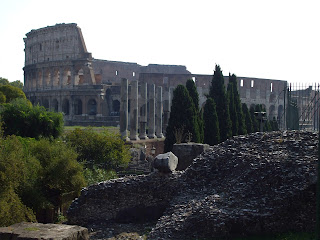
Dikleziánovi lázně se nacházejí přímo před hlavním vlakovým nádražím Termini v Římě.
My jsme se do lázní vypravili vrámci týdne kultury v Itálii.
by google translator
The Baths of Diocletian is located right outside the main railway station Termini in Rome.
We went to the spa As part of Culture Week in Italy.
Římské lázně ve své době byly centrem kultury, společenské prestiže a životního stylu. Diokleziánovi lázně sice nepatřili k těm společensky nejvýznamějším, měli pouze vyplnit potřeby Římských měštanských čtvrtí, nicméně ve své době, byly lázněmi největšími. Stavba lázní, na pokyn císaře Massimiliána, začala v roce 298 našeho letopočtu. Lázně byly otevřené o osm let později roku 306 n.l. a fungovaly až do roku 537 n.l.
Bohužel pro nás, je po jejich uzavření čekal stejný osud, jako mnohé další Římské stavby. Byli rozebírány na stavební materiál určený pro nové stavby, zejména církevní. Římské lázně byly rozdělené do několika částí. Mezi horkým sálem s vyhřívanou podlahou a bazénem s horkou vodou, zvaným calidarium, a studeným sálem se studenou vodou, nazývaným fridarium, se nacházel sál s udržovanou teplotou vlažnou tzv. tepidarium. Z tepidaria Diokleziových lázní nechala církev vytvořit v roce 1560 kostel Svaté Marie-Santa Maria degli Angeli e dei Martiri, který byl později vyzdoben malbami Michelangela. V místech , kde se nacházel vstup do tepidária, postavila církev v šestnáctém století klášter, ve kterém je dnes umístěno národní archeologické museum.
by google translator
Roman Baths at the time was a center of culture, social status and lifestyle. The Baths of Diocletian not the ones most significant socially, they fill the needs of the Roman town neighborhoods, but at that time were the largest spa. The construction of the spa, at the direction of the emperor Massimiliano, began in 298 AD. The spa was opened eight years later, in 306 n.l. and functioned until 537 n.l.
Unfortunately for us, after their closure is expected the same fate as many other Roman buildings. They discussed the building materials for new construction. In particular, for the purposes of the Church. Roman baths were divided into several parts. The hot room of a heated floor and a swimming pool with hot water and cold-called calidarium hall with cold water called fridarium was in room with temperature maintained by the lukewarm tepidarium. The tepidarium Diokleziových bath had a church in 1560, St. Mary-church of Santa Maria degli Angeli e dei Martiri, which was later decorated with paintings of Michelangelo. In places where they found the entrance to the tepidarium, the church built in the sixteenth century monastery, which today is located the National Archaeological Museum.
M.





























